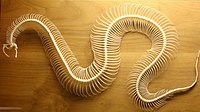
Photo from wikipedia
As a result of solicited muscles, strong friction, and tensile force on cutaneous tissue, the difference in closure procedure and management strategies and complications of surgical incision healing is a… Click to show full abstract
As a result of solicited muscles, strong friction, and tensile force on cutaneous tissue, the difference in closure procedure and management strategies and complications of surgical incision healing is a real challenge in lumbar spine surgery. We performed a retrospective study to compare different types of wound closure in lumbar spine surgery. 4383 patients were included in this study. Wound dehiscence was more common in the intracutaneous suture group than in the far‐ near‐near‐far suture group. Delayed wound healing occurred more in the far‐near near‐far suture group than intracutaneous suture group. Also, the far‐near near‐far interrupted point suture group showed a higher ratio of delayed wound healing compared with crossover suture. The superficial wound infection rate was roughly the same in all types of sutures with an average value of 0.79% with 0.81% SD. This is a preliminary study to compare different types of operative wounds showing the pros and cons related to each option.
Journal Title: International Wound Journal
Year Published: 2022
Link to full text (if available)
Share on Social Media: Sign Up to like & get
recommendations!